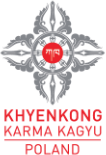Karma Kagyu is one of the four main schools of Tibetan Buddhism. Due to the uninterrupted transmission of the teachings handed down from master to student, it is called the “Line of Oral Transmission” or “Whispered Transmission Line”. The Kagyu origins go back to the 10th century in India and the teachings of the great yogi Tilopa (988-1069), who received four special transmissions of tantric teachings and mastered them.
The name “Kagyu” is, therefore, an abbreviation of the Tibetan term “four transmission lines”. It is assumed that these four secret teachings received by Tilopa were: Sangwa Dupa Tantra and Illusory Body Practice passed by Nagarjuna; Lucid Dreaming Practice (Dream Yoga) passed by Nakpopa, Clear Light Practice passed by Lawapa and Hewajra Tantra and Tumo Practice passed by Khandro Kalpa Zangmo. Tilopa passed teachings to Naropa, who combined them into a system of meditation called the “Six Yogas of Naropa”. It became the core of the Kagyu teachings. Naropa transmitted his knowledge to Marpa, called the Great Translator, believed to be the one who brought Buddha’s teachings from India to Tibet and spread them.
Milarepa was Marpa’s student, and became one of the most famous yogis of Tibet. Thanks to his dedication to the practice of Mahamudra and the Six Yogas of Naropa he reached understanding of the nature of all phenomena. He combined his teachings in the Hundred Thousand Songs of Milarepa. Milarepa gave his teachings to Gampopa, a physician from Dagpo. Gampopa was the first monk in the Kagyu tradition and created the foundations of the monastic system of the school. His “Jewel Ornament of Liberation”, in which he describes the gradual path to liberation, is the basic text of guidelines for Buddhist practitioners still today.
The 1st Karmapa Dusum Khyenpa (1110-1193) was Gampopa’s student and received from him a full set of instructions and transmissions of the Kagyu teachings, through which he achieved full realization. He began the line of Karmapas – foretold by Buddha, consciously reincarnated spiritual guides. He continued his work in his next incarnation as the 2nd Karmapa Karma Pakshi. Since then, Karmapas manifest in their successive reincarnations as the head of the Karma Kagyu School. The current Karmapa Trinley Thaye Dorje is the 17th Karmapa. Karmapas contributed to the dynamic development of the Kagyu lineage, which quickly became a widely practiced path of Buddhism in Tibet. Today it is one of the four major schools of Buddhism and its main distinguishing features are: a complete set of teachings of Mahamudra and Kadampa, emphasis on meditation practice and oral, uninterrupted transmission of the teachings from teacher to student. Karma Kagyu in Europe and America
“When fire oxen move on wheels, Iron birds fly in the sky,
And Tibetans are scattered throughout the world,
My teachings will reach the land of the red man.”
Guru Rinpoche
The above prophecy of Guru Rinpoche was realized by the 16th Karmapa, Rangjung Rigpe Dorje, a great yogi and a refugee from Tibet, who in the 1960s perceived the potential for survival and development of Buddhist teachings in Europe. At his express request lamas: Shamar Rinpoche, Kalu Rinpoche, Beru Khyentse Rinpoche, Gendyn Rinpoche, Jigme Rinpoche, Tschechu Rinpoche, Lama Teuzang and Hana&Lama Ole Nydhal started to give teachings and establish Buddhist centers in Europe. Karmapa also visited America and Europe, giving refuge and conducting ceremonies of the Black Crown. Today, Karma Kagyu centers can be found from London through Malaga, Athens, Paris, Warsaw, Budapest to Moscow. There are also retreat centers, focused on deep practice, where under the guidance of Buddhist masters, Europeans deepen their understanding of the Dharma.

